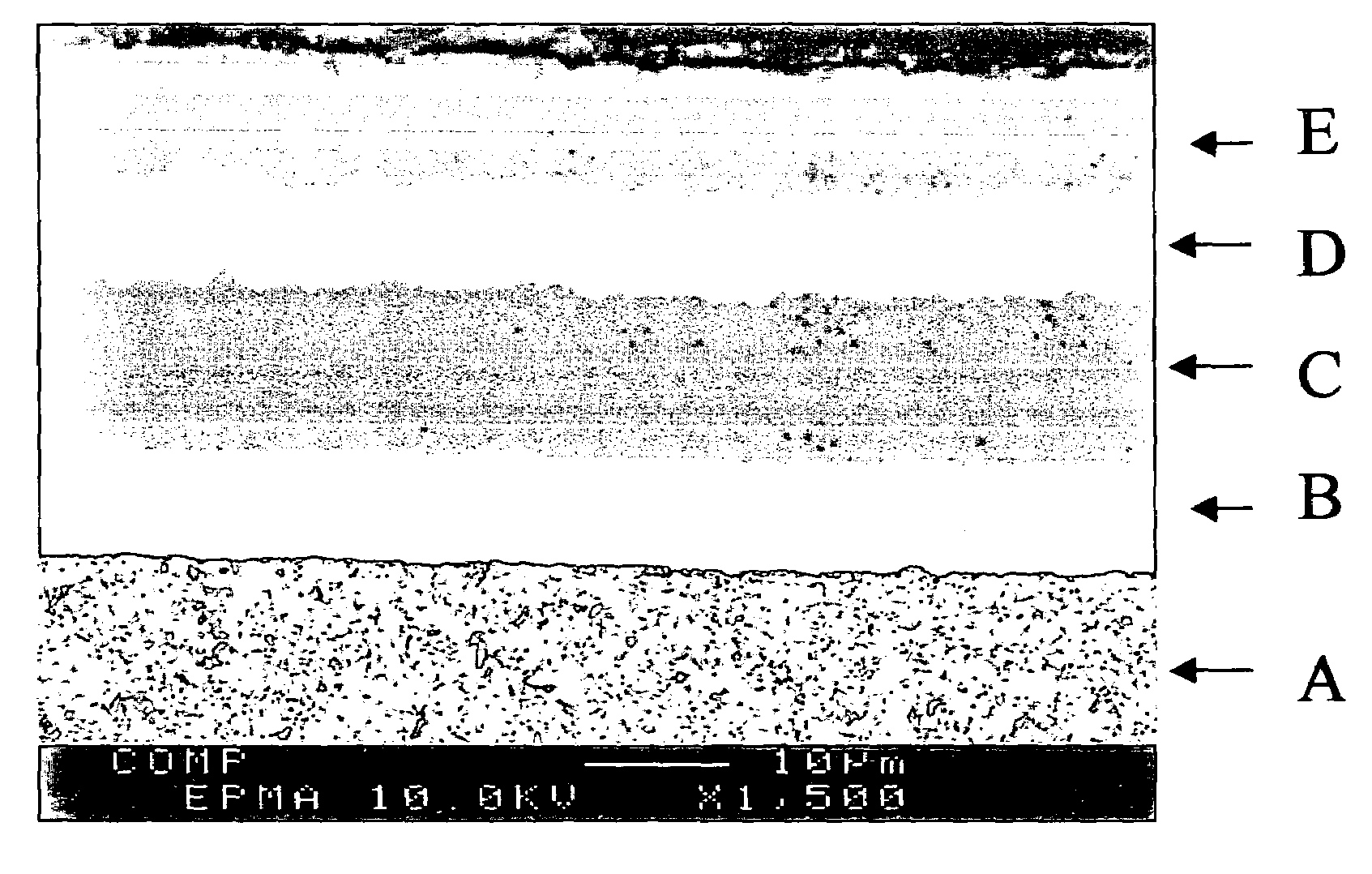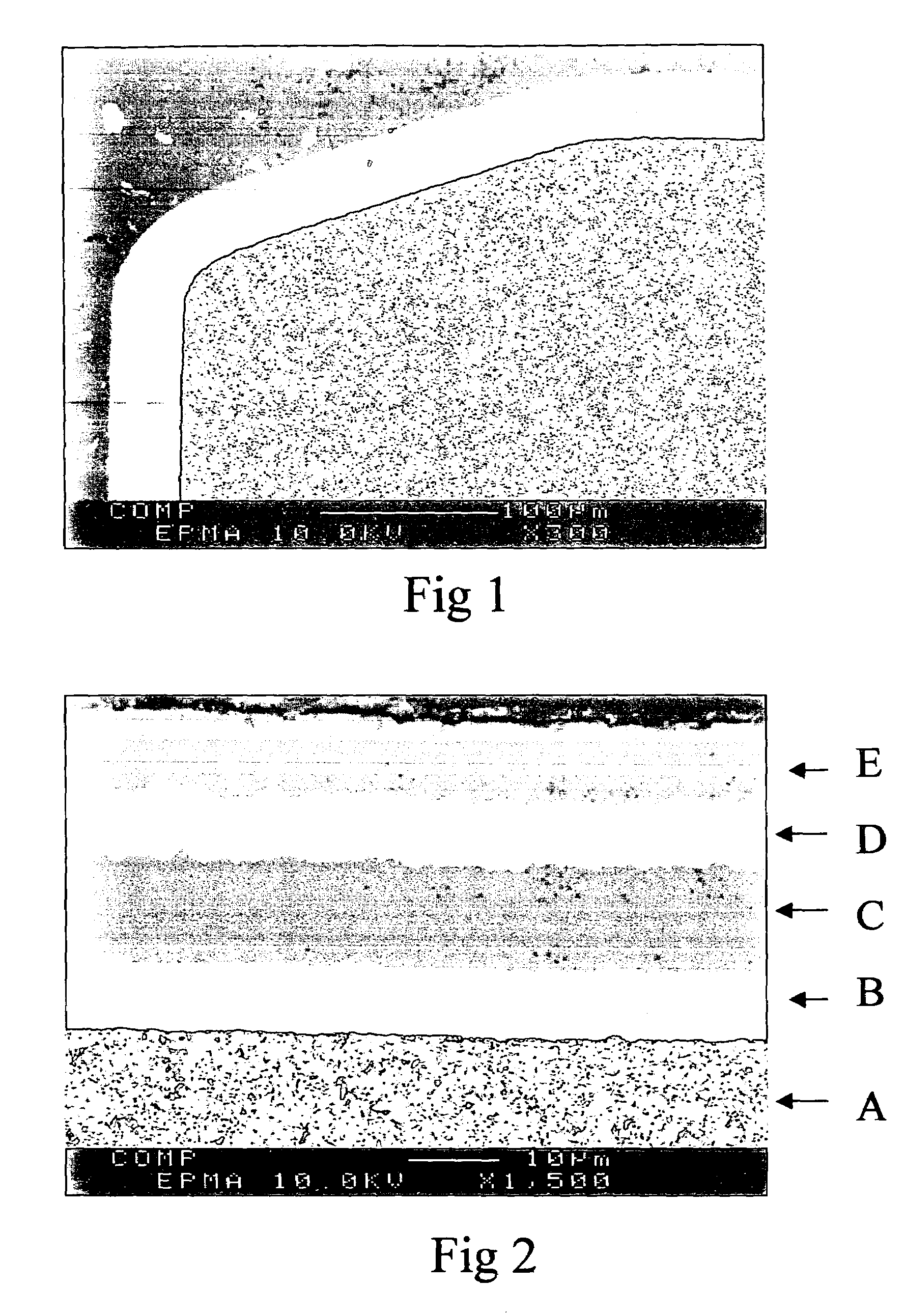Method for high speed machining and coated cutting tool
a cutting tool and high-speed technology, applied in the field of high-speed machining of metallic work pieces and a coated cemented carbide cutting insert, can solve the problem of high cost of ceramic tools, and achieve the effect of high-speed operations
- Summary
- Abstract
- Description
- Claims
- Application Information
AI Technical Summary
Benefits of technology
Problems solved by technology
Method used
Image
Examples
example 1
[0047]Cemented carbide substrates A-D with compositions according to table 1 were produced in the conventional way from powders, which were milled, pressed and sintered with or without grounding to insert shapes, ISO standard CNMA120416 T02020 and CNMA120416-KR. Furthermore the inserts were subjected to mechanical edge rounding.
[0048]After that the inserts were cleaned and coated using processes known in the art. Coating compositions and thicknesses appear from Table 2.
[0049]Two major types of layers Ti(C,N) and α-Al2O3 were deposited. Ti(C,N) was deposited so that a columnar grain structure of the layer was obtained. This was done by using the known MT-CVD process (MT-medium temperature, CVD-chemical vapor deposition) where besides other gases acetonitrile, CH3CN, was used as nitrogen and carbon source.
[0050]In the start of the coating process, at the transition zone between Ti(C,N) and Al2O3 layers and at the end of the coating process conventional processes were also used. These ...
example 2
[0054]Inserts of style CNMA120416 T02020 with an edge radius of 30 um (as measured on the uncoated insert) with substrates A, B and C with coating 1 or 2 or 6 designated A / 1, B / 2, B / 6 and C / 2, respectively and B / 4 and D / 5 were subjected to a high-speed cutting test in brake discs of a grey cast iron. The discs had a diameter of 139 mm, comprising small plane surfaces oriented at different angles towards the body axis. The flank wear width of the cutting edge after 150 discs was measured. As references were inserts B / 4 and commercially available Si3N4 ceramic insert with the same geometry used.
Machining Data
[0055]
Work piece:SS0120, grey cast iron.Type of operation:continuous internal turning operation.Cutting speed:varying from 500 to 1000 m / min, mostly over900 m / minDepth of cut:2-4 mm.Feed:0.5 mm / rev.Coolant:dry operation.Cutting time:per piece total up to 10 sec, comprising single cutsof various time lengths.RESULTS:InsertFlank wear, mmA / 1 invention0.17B / 2 invention0.18C / 2 inventio...
example 3
[0056]Example 2 was repeated with inserts A / 1, D / 1, A / 2, B / 2, A / 3, B / 6, B / 4 and C / 5 with brake discs of diameter 177 mm. The number of machined discs until the inserts were worn out was determined.
Cutting Data
[0057]
Work piece:SS0120, grey cast iron.Type of operation:continuous internal turning operation.Cutting speed:varying from 600 to 1200 m / min, mostly over1000 m / min)Depth of cut:2-4 mm.Feed:0.5 mm / rev.Coolant:dry operation.Cutting time:per piece total up to 10 sec, comprising single cutsof various time lengths.RESULTS:InsertNumber of discsA / 1 invention233D / 1 invention177A / 2 invention203B / 2 invention191A / 3 invention240B / 6 invention201B / 4 prior art80C / 5 prior art55Si3N4 ceramic / Reference217
PUM
| Property | Measurement | Unit |
|---|---|---|
| total thickness | aaaaa | aaaaa |
| thickness | aaaaa | aaaaa |
| thickness | aaaaa | aaaaa |
Abstract
Description
Claims
Application Information
 Login to View More
Login to View More - R&D
- Intellectual Property
- Life Sciences
- Materials
- Tech Scout
- Unparalleled Data Quality
- Higher Quality Content
- 60% Fewer Hallucinations
Browse by: Latest US Patents, China's latest patents, Technical Efficacy Thesaurus, Application Domain, Technology Topic, Popular Technical Reports.
© 2025 PatSnap. All rights reserved.Legal|Privacy policy|Modern Slavery Act Transparency Statement|Sitemap|About US| Contact US: help@patsnap.com


